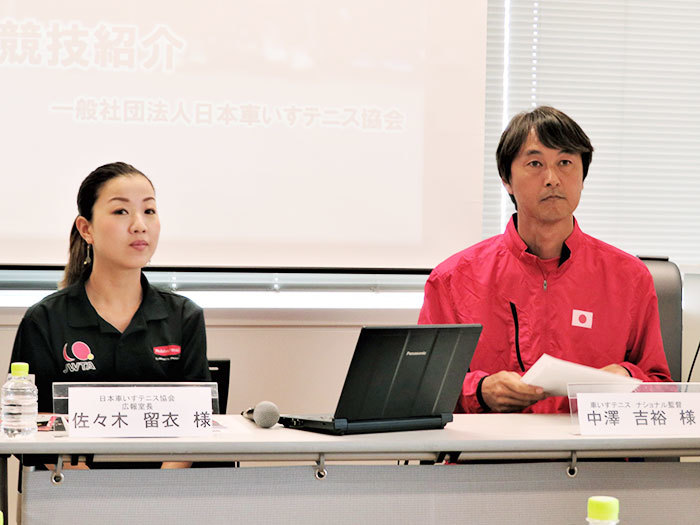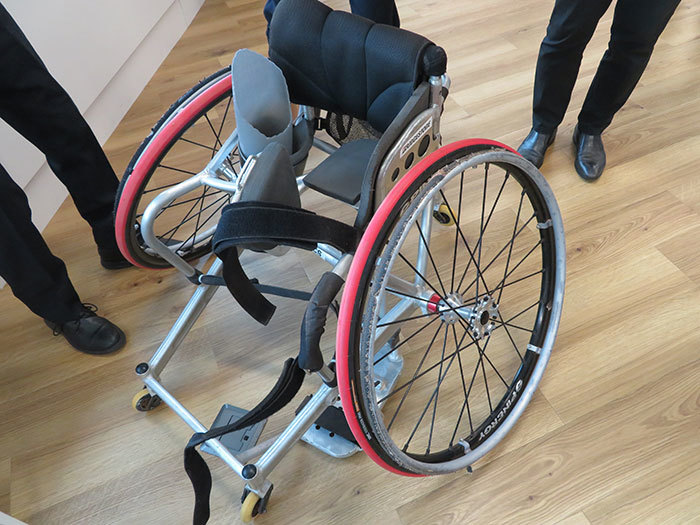Introducing the most popular sport with the highest recognition among parasports "Parasports Media Forum: Wheelchair Tennis" held
Dentsu Inc. Public Relations and the Parasports Promotion Network held the 23rd Parasports Media Forum: Wheelchair Tennis in Tokyo on October 10.
Approved by the Japan Sports Association for Persons with Disabilities, the forum focuses on one sport per session with the aim of promoting media understanding of parasports and para-athletes and improving the environment for media coverage. This time, the theme was "Wheelchair Tennis," coming right after the "Rakuten Japan Open Wheelchair Tennis Championships 2019" and ahead of the "94th Mitsubishi All Japan Tennis Championships" scheduled for October 26 to November 3.
Wheelchair tennis boasts the highest recognition among para sports in various domestic surveys and is a highly popular sport. The rules and courts used are almost identical to standard tennis, with the major difference being that returns must be made within two bounces. Players are prohibited from lifting their hips when hitting the ball, using their feet for braking or changing direction, or placing their feet on the ground.
It has been an official Paralympic sport since the 1992 Barcelona Games. The competition is divided into three classes: Men's Class, Women's Class, and Quad Class, each featuring singles and doubles events. The Men's and Women's Classes are for athletes with lower limb impairments who use wheelchairs. The Quad Class is for athletes with impairments affecting three or more limbs, including the upper limbs (mixed gender). In the Quad Class, depending on the nature of the impairment, athletes may tape their hands to the racket for stability or use electric wheelchairs.
Wheelchair tennis events are also held at the four major international tournaments, the "Grand Slam" (a collective term for the Australian Open, French Open, Wimbledon Championships, and US Open), as defined by the International Tennis Federation. Furthermore, numerous international tournaments are held worldwide, categorized by player level and age, including Grand Slams, Super Series (SS), ITF1, ITF2, ITF3, and Futures events (Japan hosts seven international tournaments). This is a sport gaining increasing attention.
The first half featured explanations of competition rules and Paralympic qualification criteria by Yoshihiro Nakazawa, National Wheelchair Tennis Coach; Rui Sasaki, Public Relations Director of the Wheelchair Tennis Association; and Naoko Tsukamoto, Executive Director. The second half featured world No. 10 player Taku Sanada, who discussed tactics and mental preparation while actually using a wheelchair.


Mr. Nakazawa stated that wheelchair tennis players fundamentally require "physical and mental strength." He added, "Because it's a battle of wits, 'quick thinking' to assess the match flow and instantly decide the next play, 'excellent insight into opponents' strategies' as a competitive sport, and 'the ability to shift thinking' when problems arise during matches. These are vital qualities, and their manifestation in the form of in-match tactics is the true essence of the sport."

The number of athletes participating in the Tokyo Paralympics is 56 for men, 32 for women, and 16 for quad class. There is no host country quota. The selection criteria require athletes to have participated in at least two World Cups during the 2017-2020 Paralympic cycle, with one of those appearances occurring in either 2019 or 2020. If an athlete does not meet these requirements, they must qualify under one of three exception criteria, such as being unable to participate due to injury. Once the main or exception criteria are met, athletes are recommended for the national team through one of four methods:
・Winners of the Asian Para Games and Parapan American Games
・Selection based on world rankings (Top 40 men, top 22 women, top 12 quads as of June 8, 2020)
・Selection via wildcard (allocated to players not selected directly via ranking, when a country has unused slots within its maximum quota)
・Selection via doubles ranking (allocation slots for players with superior doubles rankings)
Maintaining or improving one's world ranking is essential for selection as a Paralympic representative. Rankings are determined based on points earned in eligible tournaments throughout the year (9 tournaments for men, 8 for women, 7 for quads), with only the highest-scoring tournaments counted. Earned points expire after one year, requiring athletes to consistently win. Sanada, who participated this time, is no exception. He shared his approach: "Since winning every tournament isn't guaranteed, I aim to participate in twice as many tournaments as the required number for earning valid points (9 tournaments for men). By continuing to compete, I maintain my physical condition and match feel while boosting my motivation. Furthermore, I gather data on my opponents."

Wheelchair tennis demands a grueling path to national team selection, requiring near-constant competition and training with little rest to deliver results. On the other hand, Japanese athletes have achieved significant success: at the Athens Games, Shingo Kunieda and Satoshi Saida won gold in men's doubles; at the Beijing Games, Kunieda won gold in men's singles and Kunieda/Saida won bronze in men's doubles; Saita in men's doubles. At the Rio de Janeiro Games, Kunieda won gold in men's singles, while Kunieda and Saita took bronze in men's doubles, and Yui Uchi won bronze in women's singles. Japan's wheelchair tennis team has consistently delivered strong results, raising high expectations for their performance at the Tokyo Paralympics.
Looking ahead, test events for the Tokyo 2020 Games are scheduled: Uchi vs. Momoko Ohtani on October 27th, and Kunieda vs. Sanada on October 28th.
Information on various wheelchair tennis tournaments, match results, and the schedule for experience sessions and clinics can be found on the Japan Wheelchair Tennis Association website.
Was this article helpful?